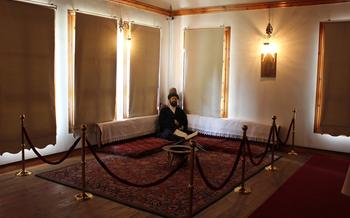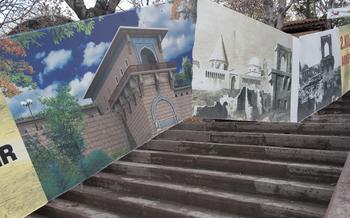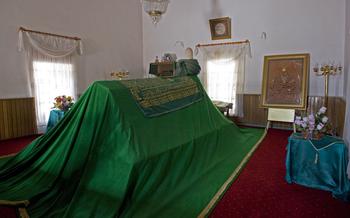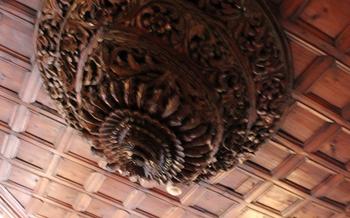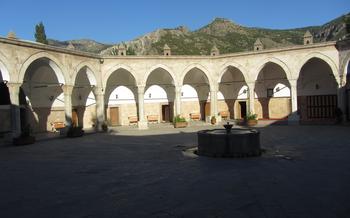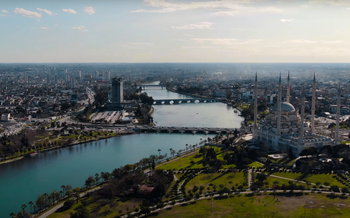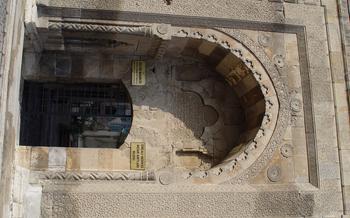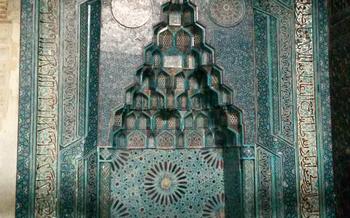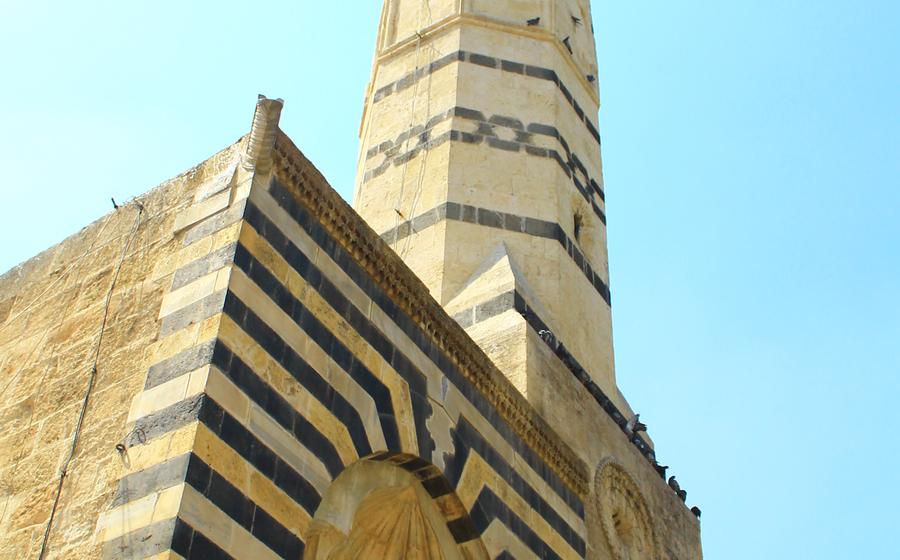
Ulu Camii (The Great Mosque)
- A Monumental Masterpiece: Unveiling the Ulu Camii's Grandeur
- Step Back in Time: Exploring the Ulu Camii's History
- Architectural Marvels: Deciphering the Ulu Camii's Design
- A Journey into the Past: Discovering the Ulu Camii's Historical Context
- A Place of Worship: Unveiling the Ulu Camii's Religious Significance
- Exploring the Ulu Camii's Interior: A Realm of Beauty and Serenity
- The Ulu Camii's Minaret: A Beacon of Islamic Architecture
- Visitor Information: Planning Your Visit to the Ulu Camii
- Unveiling the Ulu Camii's Hidden Treasures: Discoveries and Restoration Efforts
- The Ulu Camii in the Eyes of Travelers: Personal Experiences and Reflections
- Beyond the Ulu Camii: Exploring Adana's Other Architectural Wonders
- Local Cuisine: Savoring Adana's Culinary Delights
- Insider Tip: Unveiling a Hidden Gem
A Monumental Masterpiece: Unveiling the Ulu Camii's Grandeur
Standing as a testament to the architectural prowess of the Seljuk Empire, the Ulu Camii (The Great Mosque) in Adana is a magnificent edifice that exudes historical significance and cultural importance. Built in the 13th century, this architectural marvel showcases intricate stonework and embodies the essence of Seljuk artistry. The Ulu Camii is not just the largest mosque in Adana but also a symbol of the city's rich Islamic heritage, captivating visitors with its unique features and impressive dome design.
The Ulu Camii's construction dates back to the 13th century, during the reign of the Seljuk Sultan Alaeddin Keykubad I. This monumental mosque was built using the finest materials and techniques, reflecting the Seljuks' mastery of architectural design. Its grandeur lies in the intricate stonework that adorns its façade, showcasing floral motifs, geometric patterns, and Kufic inscriptions that tell stories from the Quran. The Ulu Camii's unique features set it apart from other mosques in the region, making it a must-visit attraction for anyone interested in history, architecture, or Islamic culture.
Step Back in Time: Exploring the Ulu Camii's History
The Ulu Camii's story begins in the 13th century when the Seljuk Empire ruled over Anatolia. Commissioned by the Seljuk sultan, Alaeddin Keykubad I, the mosque's construction commenced in 121Skilled artisans and architects worked tirelessly to bring the sultan's vision to life, using local materials and traditional techniques.
Over the centuries, the mosque underwent several renovations and additions, reflecting the changing architectural styles and influences of different eras. During the Ottoman period, the mosque received significant attention and modifications. In the 16th century, Sultan Suleiman the Magnificent ordered the construction of a new minaret, which still stands today as a testament to Ottoman craftsmanship.
Despite facing numerous challenges, including earthquakes and natural disasters, the Ulu Camii has remarkably endured the test of time. Its resilience stands as a symbol of the mosque's enduring significance and the dedication of the community to preserving its architectural heritage. Today, the Ulu Camii continues to serve as an active place of worship, welcoming worshippers and visitors alike to experience its spiritual and historical grandeur.
Architectural Marvels: Deciphering the Ulu Camii's Design
The Ulu Camii stands as a testament to the architectural prowess of the Seljuk Empire. Constructed in the 13th century, the mosque embodies the distinctive characteristics of Seljuk architecture, blending intricate stonework, graceful domes, and towering minarets.
Seljuk Architectural Style: A Legacy of Elegance
The Seljuk architectural style, influenced by Byzantine and Islamic traditions, is characterized by its intricate stonework, geometric patterns, and elegant proportions. The Ulu Camii showcases these elements in abundance, with its finely carved stone facades, decorative arches, and mesmerizing geometric designs.
Stonework and Carvings: A Tapestry of Symbolism
The mosque's exterior is adorned with intricate stone carvings, each element imbued with symbolic meaning. From the delicate arabesques to the stylized Kufic inscriptions, the carvings narrate stories from the Quran, celebrate the virtues of Islam, and pay homage to the Seljuk sultans.
Domed Structure: A Masterpiece of Engineering and Aesthetics
The Ulu Camii's most striking feature is its impressive dome, a testament to the Seljuk's engineering prowess. The massive dome, supported by four massive pillars, creates a sense of awe-inspiring grandeur, while its intricate geometric patterns add a touch of elegance and sophistication.
Minaret: A Symbol of Islamic Architecture and Divine Connection
The Ulu Camii's towering minaret, a symbol of Islamic architecture, serves as a beacon guiding the faithful to prayer. Adorned with intricate carvings and crowned by a graceful balcony, the minaret stands as a symbol of the mosque's religious significance and the connection between heaven and earth.
A Journey into the Past: Discovering the Ulu Camii's Historical Context
Before delving into the architectural intricacies of the Ulu Camii, it is essential to understand its historical context. Adana, the city in which the mosque resides, has a rich and storied past that predates the mosque's construction. In the 13th century, when the mosque was built, Adana was under the rule of the Seljuk Empire, a powerful dynasty that left an indelible mark on Anatolia's architectural and cultural landscape. The Ulu Camii stands as a testament to the Seljuk's architectural prowess and their commitment to Islam.
The Seljuk Empire, with its capital in Konya, Anatolia, emerged as a dominant force in the 11th century. The Seljuks, originally nomadic tribes from Central Asia, rapidly expanded their territory, conquering vast regions of the Middle East and Anatolia. Their reign ushered in a golden age of Islamic art and architecture, characterized by intricate stonework, soaring domes, and elegant minarets. The Ulu Camii, with its Seljuk architectural style, is a prime example of this artistic legacy.
The construction of the Ulu Camii coincided with the Seljuk Empire's expansion into Anatolia. As the Seljuks conquered new territories, they established mosques and other religious structures to consolidate their power and promote Islam. The Ulu Camii, with its imposing size and elaborate design, served as a symbol of Seljuk authority and their commitment to spreading the Islamic faith.
In the centuries that followed, the Ulu Camii underwent several renovations and additions, reflecting the changing political and cultural landscape of Adana. During the Ottoman period, the mosque received significant modifications, including the addition of a new minaret and the expansion of the prayer hall. These renovations demonstrate the enduring importance of the Ulu Camii, not only as a religious center but also as a symbol of Adana's rich history and cultural heritage.
A Place of Worship: Unveiling the Ulu Camii's Religious Significance
The Ulu Camii stands as a testament to Adana's deep-rooted Islamic heritage, serving as a central place of worship for the city's Muslim community. It plays a pivotal role in the daily religious observances of Adana's residents, facilitating congregational prayers five times a day and hosting special ceremonies during religious holidays. Its spacious prayer hall can accommodate a vast number of worshippers, fostering a sense of unity and communal spirit. Beyond its practical function, the Ulu Camii also serves as a sanctuary for spiritual reflection and contemplation, providing a tranquil environment for individuals to connect with their faith. The mosque's serene atmosphere and intricate Islamic decorations contribute to its sacred ambiance, inviting worshippers to immerse themselves in prayer and devotion.
Exploring the Ulu Camii's Interior: A Realm of Beauty and Serenity
Step inside the Ulu Camii, and you will be greeted by a vast and awe-inspiring interior that exudes an aura of tranquility and devotion. The prayer hall, the heart of the mosque, is a spacious and elegant chamber where worshippers gather for their daily prayers. Its high ceiling, supported by rows of stately columns, creates a sense of grandeur and reverence.
The mihrab, the intricately designed niche in the wall that indicates the direction of prayer, is a masterpiece of craftsmanship. Its ornate carvings and colorful tiles form a mesmerizing display of Islamic artistry. Beside the mihrab stands the minbar, an elevated platform from which the imam delivers sermons and leads prayers. Its intricate woodwork and elegant design add to the mosque's overall aesthetic appeal.
The courtyard, an integral part of the mosque's architecture, provides a serene outdoor space for contemplation and reflection. Surrounded by graceful arches and adorned with a central fountain, the courtyard offers a tranquil retreat from the bustling city outside. Its serene atmosphere invites visitors to pause and appreciate the beauty and tranquility that permeate the mosque's interior.
The Ulu Camii's Minaret: A Beacon of Islamic Architecture
The Ulu Camii's minaret, piercing the sky with its slender form, stands as a testament to the mosque's grandeur and the architectural prowess of the Seljuk era. Towering over the mosque's courtyard, the minaret commands attention with its intricate details and imposing height. Its cylindrical structure, adorned with bands of decorative brickwork and intricate geometric patterns, showcases the Seljuks' mastery of ornamental design.
The minaret, like its counterparts in other Seljuk mosques, serves a functional purpose beyond its aesthetic appeal. Its primary role lies in the call to prayer, echoing the melodic voice of the muezzin across the city, summoning the faithful to their daily prayers. The minaret's elevated position ensures that the call reaches every corner of the surrounding neighborhood, reminding the community of their religious obligations.
Beyond its functional role, the minaret holds symbolic significance in Islamic architecture. Its towering presence represents the connection between the earthly realm and the divine, symbolizing the aspiration towards spiritual transcendence. The minaret's graceful lines and intricate embellishments reflect the Seljuks' deep reverence for their faith and their dedication to beautifying the spaces dedicated to worship.
As visitors gaze upon the Ulu Camii's minaret, they are transported back in time to the era of the Seljuk Empire, when architectural marvels like this were constructed with meticulous precision and adorned with intricate details. The minaret stands as a silent witness to the city's rich history, a testament to the enduring legacy of Islamic architecture in Turkey.
Visitor Information: Planning Your Visit to the Ulu Camii
Location and Accessibility:
The Ulu Camii stands proudly in the heart of Adana, easily accessible from various points within the city. Situated along the Ceyhan River and within walking distance from the city's central attractions, the mosque is a prominent landmark that invites both locals and visitors to explore its architectural wonders.
Visiting Hours and Guidelines:
As an active place of worship, the Ulu Camii welcomes visitors during specific hours, ensuring respect for ongoing religious activities. Visitors are kindly requested to adhere to the mosque's guidelines, which include maintaining a respectful demeanor, avoiding loud conversations, and dressing appropriately.
Dress Code:
In keeping with Islamic customs, visitors are expected to dress modestly when visiting the Ulu Camii. While there is no strict dress code, it is advisable for both men and women to wear clothing that covers their shoulders and knees. This demonstrates respect for the mosque's religious significance and helps maintain a serene atmosphere.
Photography Guidelines:
Photography is generally permitted within the Ulu Camii, allowing visitors to capture the mosque's architectural details and intricate ornamentation. However, it is important to be mindful of ongoing prayers and avoid using flash photography or causing any disruption to worshippers. Seeking permission from the mosque's caretaker before taking photographs is always a courteous gesture.
Unveiling the Ulu Camii's Hidden Treasures: Discoveries and Restoration Efforts
Beneath the Ulu Camii's surface lie hidden treasures that reveal its rich history and enduring legacy. Archaeological excavations conducted in the surrounding area have unearthed ancient artifacts and foundations, shedding light on the mosque's origins and the city's past. These discoveries provide valuable insights into the architectural evolution of the Ulu Camii and its place within the broader context of Adana's urban development.
Restoration projects have been undertaken to preserve the mosque's architectural integrity and ensure its continued existence for future generations. Skilled artisans work meticulously to restore intricate stone carvings, repair damaged structures, and maintain the mosque's overall aesthetic appeal. These efforts require immense dedication and expertise, as they involve preserving the mosque's historical authenticity while addressing the effects of time and wear.
The Ulu Camii's conservation challenges are multifaceted, ranging from natural wear and tear to the impact of human activity. Regular maintenance and vigilant monitoring are essential to address these challenges and safeguard the mosque's structural integrity. Addressing the challenges requires a collaborative effort involving experts in architecture, conservation, and cultural heritage preservation.
As the Ulu Camii stands tall, its future plans focus on ensuring its enduring legacy. Ongoing restoration projects aim to preserve its architectural grandeur and historical significance for generations to come. The mosque's enduring presence serves as a testament to the enduring spirit of Adana and its commitment to preserving its cultural heritage.
The Ulu Camii in the Eyes of Travelers: Personal Experiences and Reflections
The Ulu Camii has captivated the hearts and minds of countless travelers who have stepped within its hallowed walls. For some, it was the sheer grandeur of the architecture that left an indelible impression. The intricate stonework, the soaring dome, and the graceful minaret combined to create a sense of awe and wonder.
For others, it was the mosque's spiritual atmosphere that touched them deeply. The hushed whispers of prayers, the rhythmic chanting of the Quran, and the sense of serenity that permeated the air created a profound and moving experience. Visitors from all walks of life and faiths have found solace and inspiration within the Ulu Camii, regardless of their religious beliefs.
Cultural encounters with the locals added another layer of depth to the experience. Visitors engaged in conversations with friendly locals, learning about their customs, traditions, and personal connections to the mosque. These interactions provided a deeper understanding of the role the Ulu Camii plays in the daily lives of Adana's residents.
The Ulu Camii's enduring legacy lies in the lasting memories it creates in the minds of those who visit it. Whether it's the awe-inspiring architecture, the spiritual ambiance, or the warm encounters with locals, the mosque leaves an imprint that stays with travelers long after they depart from Adana.
Beyond the Ulu Camii: Exploring Adana's Other Architectural Wonders
Adana is a city that boasts a rich architectural heritage beyond the Ulu Camii. Visitors can embark on a journey to discover other historic mosques that showcase the diverse styles and influences that have shaped the city's skyline. The Sabancı Merkez Camii, with its modern design and soaring minarets, stands as a testament to Adana's contemporary architectural achievements.
For those interested in exploring religious diversity, Adana offers a captivating array of churches and synagogues. The Holy Virgin Mary Chaldean Cathedral exudes an aura of serenity with its elegant facade and ornate interiors, while the Great Synagogue of Adana stands as a symbol of the city's vibrant Jewish community.
Adana's architectural tapestry is further enriched by its ancient ruins and monuments. The Misis Archaeological Site, located just outside the city, offers a glimpse into the region's rich history, with its well-preserved Roman ruins and stunning mosaics. The Anavarza Castle, perched atop a hill overlooking the city, invites visitors to explore its ancient fortifications and immerse themselves in the tales of past civilizations.
In contrast to its rich historical heritage, Adana also boasts a modern architectural landscape. The Adana HiltonSA Hotel, with its sleek design and glass facade, represents the city's embrace of contemporary architectural trends. The Adana Merkez Park, a sprawling urban park, showcases innovative landscaping and modern sculptures, creating a harmonious blend of nature and urban design.
Whether you're drawn to the grandeur of historic mosques, the intricate details of religious sites, the allure of ancient ruins, or the sleek lines of modern architecture, Adana offers a captivating journey through its diverse architectural treasures, inviting visitors to discover the city's rich cultural heritage and dynamic spirit.
Local Cuisine: Savoring Adana's Culinary Delights
Adana's culinary scene is a symphony of flavors, a testament to the city's rich cultural heritage and diverse influences. From traditional dishes that have stood the test of time to mouthwatering street food that tantalizes the senses, Adana offers a culinary journey that will delight your taste buds and leave you craving for more.
Traditional Dishes:
-
Adana Kebab: A succulent skewer of minced lamb, grilled to perfection and seasoned with aromatic spices, is a must-try for any visitor to Adana. Its unique flavor and tender texture have earned it a reputation as one of Turkey's most beloved dishes.
-
Ciger Kebap: For those who love offal, Ciger Kebap is a delicacy not to be missed. Tender lamb liver is skewered and grilled, resulting in a dish that is both flavorful and nutritious.
-
Soyleme: This traditional Adana soup is a hearty and comforting dish, made with lamb or beef broth, chickpeas, and bulgur. Its rich flavor and warming aroma make it a popular choice during the colder months.
Street Food:
-
Tantuni: A local favorite, Tantuni is a wrap made with thin lavash bread, filled with grilled meat, tomatoes, onions, and parsley. Its simplicity belies its delicious taste, making it a popular on-the-go snack.
-
Sekerpare: These sweet treats are a staple of Adana's street food scene. Made with semolina flour, butter, and sugar syrup, they are a perfect way to end a meal on a sweet note.
Local Markets:
- Kazancılar Çarşısı: Immerse yourself in the vibrant atmosphere of Adana's traditional market, where you can find fresh produce, spices, textiles, and handicrafts. The air is filled with the sounds of vendors calling out their wares and the scent of freshly baked bread.
Culinary Traditions:
-
Meze Culture: Adana's meze culture is a celebration of small plates and shared dishes. From hummus and baba ghanoush to pickled vegetables and grilled halloumi, these appetizers are a delightful way to start any meal.
-
Baklava: No culinary journey in Turkey is complete without sampling the country's famous baklava. Adana's version is known for its delicate layers of filo pastry, filled with chopped nuts and sweetened with syrup.
Insider Tip: Unveiling a Hidden Gem
Beyond the bustling streets and iconic landmarks, Adana holds a secret gem waiting to be discovered. Nestled in the heart of the old city, concealed amidst narrow alleyways and traditional houses, lies a hidden architectural treasure. It is a centuries-old caravanserai, once a vibrant hub of trade and cultural exchange, now transformed into a charming boutique hotel.
As you step through the caravanserai's ancient gates, you are transported back in time. The courtyard, adorned with intricate carvings and a central fountain, evokes a sense of tranquility and wonder. The surrounding rooms, once used by weary travelers, have been meticulously restored, retaining their original character while offering modern comforts.
Staying in this hidden gem is an experience unlike any other. You can soak in the rich history that permeates every corner of the caravanserai, while enjoying the warm hospitality and personalized service of the hotel staff. Don't miss the opportunity to savor traditional Turkish cuisine in the caravanserai's intimate restaurant, overlooking the serene courtyard.
This secret spot is a true gem for those seeking an authentic and immersive experience in Adana. It offers a glimpse into the city's rich past and provides a unique perspective on its vibrant culture. Whether you're a history buff, an architecture enthusiast, or simply someone who appreciates hidden treasures, this hidden gem is sure to captivate your senses and leave you with lasting memories.
